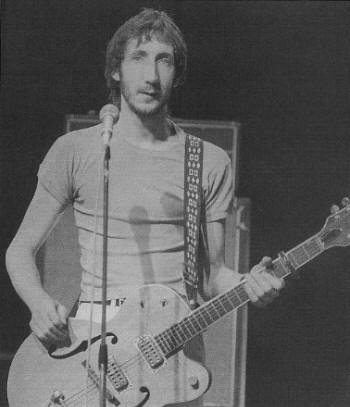Pete’s Gear: 1959 Gretsch 6120 ‘Chet Atkins’ Hollow Body
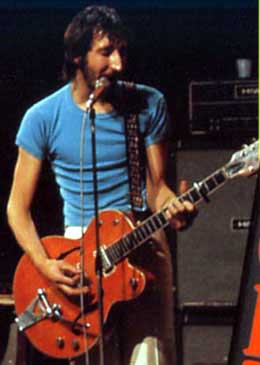
Top of the Pops, 3 Oct. 1973.
Introduction: Pete Townshend’s 1959 Gretsch 6120 ‘Chet Atkins’ Hollow Body guitar
The guitar that made Pete’s defining electric sound on record. Combined with an Edwards pedal steel volume pedal, a Whirlwind cable and a ’59 Fender 3×10 Bandmaster amplifier, all a gift from Joe Walsh in 1970, Pete created the feedback-laden sound heard on most all post-Tommy Who and solo recordings, most significantly, Who’s Next (1971) and Quadrophenia (1973).
This guitar was used almost exclusively for recording work (Pete claimed it wouldn’t stay in tune for stage work), excepting the Eric Clapton comeback concert in January 1973 (for which Clapton gave Pete a 1957 Fender Stratocaster as thanks) and for a television appearance on Top of the Pops on 3 Oct. 1973 (as seen in the outro credits in The Kids Are Alright film), where Pete smashed the guitar (because of the BBC’s insistence that they shorten 5.15), but later had it repaired.
He continued to employ it on virtually all Who and solo recordings, at least up to 1993’s Psychoderelict, and still retains the guitar.
Note: Pete often is quoted as identifying this guitar as a 1957 Chet Atkins model or a Country Gentleman model. However, all photographic evidence of Pete’s studio use of a Gretsch hollowbody indicate this is a 1959 Chet Atkins Hollow Body model, as indicated by the Filter’Tron pickups, dual top-bout switches, V-shaped nickel-plated Bigsby and zero fret, all features introduced in the 1958 or 1959 Chet Atkins models.
It is also possible this guitar is a 1960 model based on the ‘V’-shaped Bigsby B-6 tailpiece. Although the ‘V’-shaped Bigsby B-6 tailpiece was widely adopted in 1960, sources such as the Vintage Guitar Info pages, indicate that it had begun to be introduced in 1959. Of note, 1960 models have a 16″ × 2.5″ body, whereas 1959 models have a 16″ × 2.75″ body.
1959 model specs:
- Single cutaway 16″ × 2.75″ hollow maple body with f-holes with black and white binding, Gretsch Sunset Orange paint;
- Rosewood fretboard with “Neo-Classic” half-moon markers; “zero” fret.
- Bone nut;
- Grover StaTite tuners;
- Two PAF Filter’Tron pickups; volume control for each pickup, master volume, tone and pickup-selector switch;
- Gold pickguard, with Gretsch and Chet Atkins signpost in black (removed);
- Nickel-plated ‘V’-shaped Bigsby B-6 tailpiece with pivoting arm vibrola and compensated aluminum Bigsby bridge.
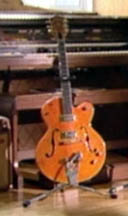
Pete’s 1959 Gretsch 6120 Chet Atkins, pictured 2004.
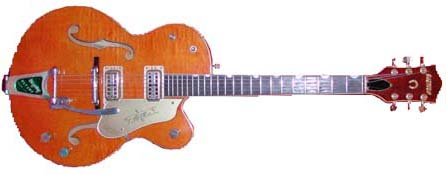
Generic 1959 Gretsch 6120 Chet Atkins (Note: This model differs from Pete’s with the non-V-shaped cutout on the Bigsby B-6 tailpiece.)
Selected quotes from Pete Townshend and John Entwistle
All quotes and references are copyright their original owners and are included for reference only.
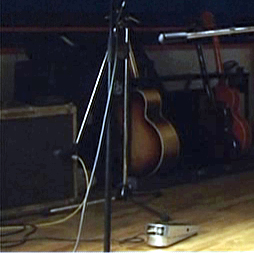
In the studio: Closeup of Edwards volume pedal, Whirlwind cable and ’59 Fender Bandmaster. Gretsch can be seen in background at right.
Scoop liner notes regarding the Bargain demo
Joe Walsh had just presented me with an old Gretsch Chet Atkins guitar and it more or less played me on this track.
Excerpt from May/June 1972 Guitar Player
PT: I never really got into old guitars until Joe Walsh (James Gang) rang me up one night and said, “I’ve got something for you,” because we buy one another presents. He buys me old concert amps and I buy him synthesizers and we have become very good friends. Anyway, he said, “I’ve got something for you,” and I said “What?” and he said, “A 1957 Gretsch.”
- GP: Chet Atkins type?
PT: Right, with real f-holes. I said, “Great, cheers, man,” and it turned out to be a real knockout. I was being polite. I opened the case and it was bright orange and I thought, “Ugh! It’s horrible, I hate it.” I went home and went into my studio and plugged it in and it totally wrecked me out, it’s the best guitar I’ve got now. It’s the Chet Atkins model, with double pickups, f-holes and single cut-away.
- GP: Doesn’t it have a mellow sound, though; it doesn’t “chunck”, does it?
PT: Oh, I used that guitar on every track on Who’s Next, it’s the best guitar I’ve ever had. It won’t stay in tune on stage but if it did, I would use it. It’s the finest guitar I’ve ever owned, it’s the loudest guitar I’ve ever owned. It is so loud, man, it whips any pickup that I’ve ever come across. It’s maybe six or seven times louder than anything I’ve come across. If I plugged it in my amp tonight, normally I’d be working on volume 6 or 7, but I would work this guitar on 1.
Excerpt from May 1996 Guitar Player
Unlike Pete’s stage equipment, which the guitarist often transformed into sawdust, toothpicks and confetti by the end of a performance, he’s hung on to and treasured this combination, even if he hasn’t exactly pampered it. “I’ve still got the Gretsch,” says Townshend, “although it got broken by accident when I trod on it. I fixed it up and it still sounds wonderful. I often use the same chain, even the exact same guitar cable — an old Whirlwind — when I’m recording. But if you try to fuck with the setup — for instance, play the Gretsch through a Zoom pedal — it doesn’t work. It’s got to be that exact combination of stuff. There are lots of setups that produce great sounds. This is ancient wisdom. Seek and ye shall find.”
Excerpt from September 1993 Guitar Player
Guitar players have always known. You get the right Strat. You get the right guitar cable. You plug it into the right old Fender amp and you get the sound. I’m just taking a safe route there. There are lots of other chains that produce great sounds.
I remember when I gave Joe Walsh an ARP 2600. He went, [mimics Joe Walsh] “Pete. I don’t know what to get you in return so I bought you a Gretsch Country Gentleman, like Neil Young uses. I know you don’t really get into them, but you should try this. And I bought you a Fender Bandmaster amplifier with three 10s so the ohmage is crazy, and an Edwards pedal steel volume pedal.” I linked it all up, went “Ya-a-ang” and it was there. When I get those three things out and put them in a chain, it’s a sound from paradise. If I try to fuck with it and say, “Wouldn’t it be interesting if I took the Gretsch and put it through a Zoom pedal,” it doesn’t work. It’s got to be just that combination of stuff.
- CG: You recorded some incredible music with that Gretsch.
PT: I’ve still got it. It got broken by accident. I trod on it. It still sounds wonderful. I’ve still got the amp and I often use it. I used it on the album. It’s the same chain, even the same guitar cable — an old Whirlwind.
Excerpt from Guitar Player, October 1989
- Do you have a favorite period in your career, where you feel you broke down what you regarded as guitaristic barriers?
I think the significant moments have actually had a lot to do with guitars, actual guitars. Like being given an orange Gretsch Country Gentleman [sic] and an Edwards [volume] pedal by Joe Walsh, and being told exactly how to set up the amp to produce that amazing Neil Young noise, and using that sound on “Won’t Get Fooled Again” and “Bargain.”
Excerpt from May 1982 Guitar Player interview with John Entwistle
Pete always seems to smash the guitars he loves, somehow. He did-in a really nice Gretsch that Joe Walsh had given him. He really liked it, but he lost his temper on Top of the Pops and broke the neck off. He’s since had it repaired. But for the most part, the stuff that Pete trashed was readily available ordinary gear that was plentiful and replaceable.
Excerpt from The Soul of Tone: Celebrating 60 Years of Fender Amps interview with Alan Rogan
[Note, Alan Rogan introduces a conflict of information here about which amp(s) Pete used for the recording of Won’t Get Fooled Again. He also indicates the Edwards volume pedal was a Goldrich (perhaps meaning Goodrich, a popular pedal steel volume pedal manufacturer.]
A mighty roar of exhilarating music, the epic Who’s Next was released in the summer of 1971. It’s invariably listed among the greatest albums of the entire rock era, and it electrifies new generations of listeners to this day. Alan Rogan: “We still have the same setup that Pete used on Who’s Next: the orange Gretsch 6120 that Joe [Walsh] gave to Pete, a tweed Bandmaster with three 10s, and the powered Goldrich volume pedal — Goldrich being manny Goldrich, from Manny’s in New York. You can hear two distinct guitar sounds on Who’s Next. One is the Gretsch, and the other is Pete’s SG. He also had a Twin and a Bassman — I’m guessing it was a blonde, early ’60s — and he used the Gretsch guitar with the Twin and the Bassman on ‘Won’t Get Fooled Again.’”
Photo Gallery
January 1973
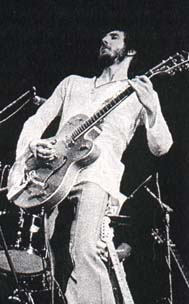
Eric Clapton’s comeback concert, January 1973.
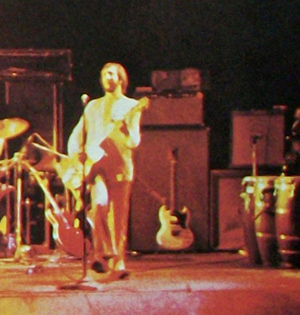
Eric Clapton’s comeback concert, January 1973, with Gretsch Chet Atkins. Amplifier is ’59 Bandmaster, on top of Hiwatt 4×12 cabinet. Spare white SG Special on stand.
Studio, 1973
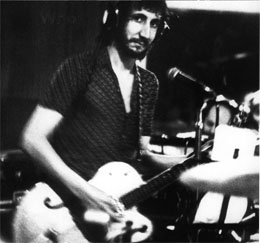
Ca. summer 1973, Ramport Studios, recording Quadrophenia.
Top of the Pops, October 1973
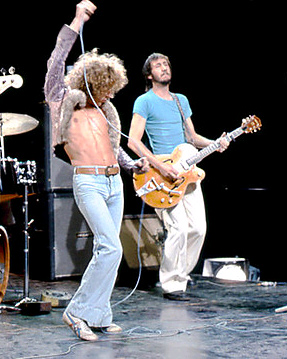
On “Top of the Pops,” 3 Oct. 1973, with Gretsch (later smashed), ’59 Bandmaster, next to Hiwatt stack.
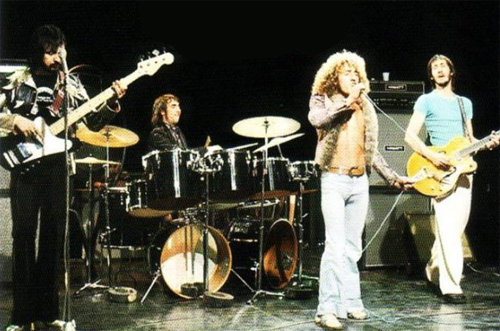
Performing 5.15 on “Top of the Pops,” 3 Oct. 1973, with Gretsch (later smashed), ’59 Bandmaster, next to Hiwatt stack.
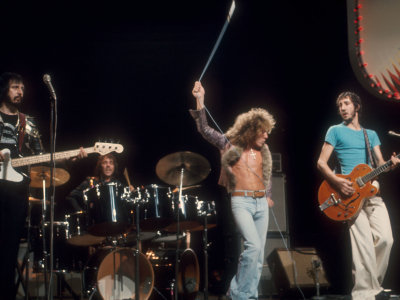
3 Oct. 1973, on “Top of the Pops” with Gretsch (later smashed), through ’59 Bandmaster tilted in front of Hiwatt stack.
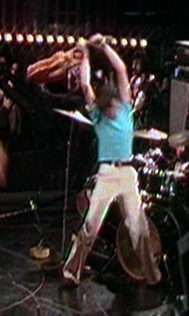
On “Top of the Pops,” 3 Oct. 1973, with Gretsch “having an accident.”
Studio, 1976–78
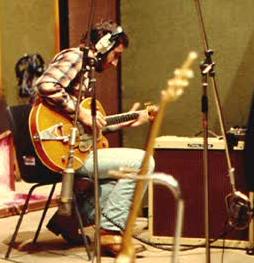
Ca. 1976/77, at Olympic Studios, recording Rough Mix, with 1970s Peavey Vintage 4×10 amplifier, coil cable and Electro-Harmonix Big Muff Pi fuzz pedal. Note pickguard in place. Therefore, this may be a different instrument. Note what appears to be a thinner body depth.
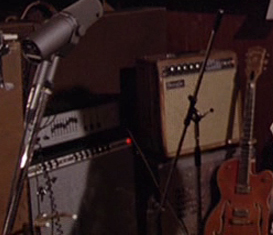
1978, at Shepperton filming Who Are You, with Gretsch visible on stand. (At right, MESA/Boogie MkI combo. At left, Gelf preamp unit on top of silverface Fender Deluxe Reverb.).
Studio, 1985
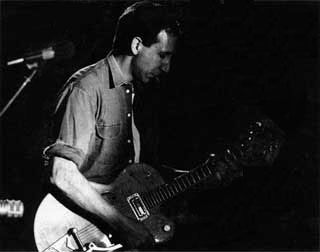
1985, White City film
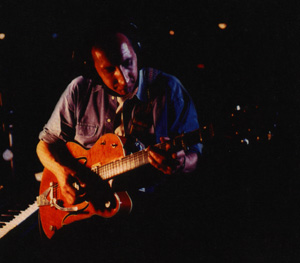
1985, White City sessions.
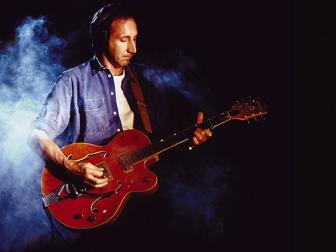
Click to view larger version. 1985, White City film.
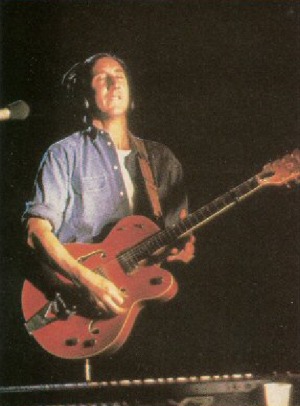
1985, White City sessions.
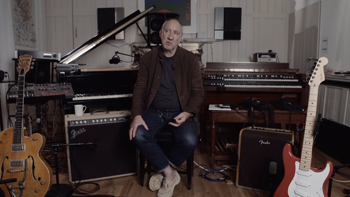
Click to view larger version. Ca. 2016, Pete at his studio promoting the Fender Custom Shop Limited Edition Pete Townshend Stratocaster®, with, from left, Gretch Chet Atkins, Fender Vibro-King, Fender Acoustic SFX and Fender Eric Clapton Stratocaster.
Resources and Information
For more information
- Gretsch Pages: gretschpages.com
- Vintage Guitars Info: guitarhq.com/gretsch.html
Manufacturers:
- Gretsch: gretschguitars.com
- Whirlwind USA: whirlwindusa.com
